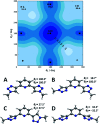Structural properties of the chelating agent 2,6-bis(1-(3-hydroxypropyl)-1,2,3-triazol-4-yl)pyridine: a combined XRD and DFT structural study
- PMID: 35515445
- PMCID: PMC9054079
- DOI: 10.1039/d0ra04142d
Structural properties of the chelating agent 2,6-bis(1-(3-hydroxypropyl)-1,2,3-triazol-4-yl)pyridine: a combined XRD and DFT structural study
Abstract
The conformational isomerism of the chelating agent 2,6-bis(1-(3-hydroxypropyl)-1,2,3-triazol-4-yl)pyridine (PTD), exploited in fuel reprocessing in spent nuclear waste, has been studied by single crystal X-ray diffraction analysis in combination with an extensive DFT conformational investigation. In the solid-state, the elucidated crystal structure (i.e., not yet published) shows that by thermal treatment (DSC) no other phases are observed upon crystallization from the melt, indicating that the conformation observed by X-ray data is rather stable. Mapping of intermolecular and intramolecular noncovalent interactions has been used to elucidate the unusual arrangement of the asymmetric unit. Considerations relating to the stability of different conformational isomers in aqueous and non-aqueous solutions are also presented. The accurate structural description reported here might open various research topics such as the potential of PTD to act as an outer sphere ligand in the formation of second sphere coordination complexes and their interconversion by mechanochemical means.
This journal is © The Royal Society of Chemistry.
Conflict of interest statement
There are no conflicts to declare.
Figures







Similar articles
-
A Complexation Study of 2,6-Bis(1-(p-tolyl)-1H-1,2,3-triazol-4-yl)pyridine Using Single-Crystal X-ray Diffraction and TRLFS.Inorg Chem. 2015 Aug 3;54(15):7301-8. doi: 10.1021/acs.inorgchem.5b00803. Epub 2015 Jul 13. Inorg Chem. 2015. PMID: 26168381
-
Design and synthesis of methyl 2-{[4-phenyl-5-(pyridin-2-yl)-4H-1,2,4-triazol-3-yl]sulfanyl}acetate (phpy2NS) as a ligand for complexes of Group 12 elements: structural assessment and hydrogen-bonded supramolecular assembly analysis.Acta Crystallogr C Struct Chem. 2019 Jul 1;75(Pt 7):891-903. doi: 10.1107/S205322961900682X. Epub 2019 Jun 11. Acta Crystallogr C Struct Chem. 2019. PMID: 31271377
-
DFT and CV data of 4-phenyl-substituted dichloro(bis{2-[1-(phenyl)-1H-1,2,3-triazol-4-yl-κN3]pyridine-κN})iron(II) coordination compounds.Data Brief. 2018 Oct 27;21:1458-1471. doi: 10.1016/j.dib.2018.10.085. eCollection 2018 Dec. Data Brief. 2018. PMID: 30456271 Free PMC article.
-
Ln(III) complexes of a bis(5-(pyridine-2-yl)-1,2,4-triazol-3-yl)methane ligand: synthesis, structure and fluorescent properties.Dalton Trans. 2013 May 21;42(19):6936-43. doi: 10.1039/c3dt50297j. Dalton Trans. 2013. PMID: 23507708
-
The Important Role of the Hydroxyl Group on the Conformational Adaptability in Bis(l-threoninato)copper(II) Compared to Bis(l-allo-threoninato)copper(II): Quantum Chemical Study.Inorg Chem. 2016 Aug 1;55(15):7694-708. doi: 10.1021/acs.inorgchem.6b01157. Epub 2016 Jul 21. Inorg Chem. 2016. PMID: 27442350
References
-
- Poinssot Ch. Bourg S. Ouvrier N. Combernoux N. Rostaing C. Vargas-Gonzalez M. Bruno J. Energy. 2014;69:199–211. doi: 10.1016/j.energy.2014.02.069. - DOI
-
- Hill C., in Ion exchange and solvent extraction. A series of advances, ed. B. A. Moyer, CRC Press, Boca Raton, FL, 2019, pp.119–193
-
- Modolo G., Geist A. and Miguirditchian M., in Reprocessing and recycling of spent nuclear fuel, ed. R. Taylor, Woodhead Publishing, Oxford, UK, 2015, pp. 245–287
-
- Mathur J. N. Murali M. S. Nash K. L. Solvent Extr. Ion Exch. 2001;19:357–390. doi: 10.1081/SEI-100103276. - DOI
-
- Bourg S. Hill C. Caravaca C. Rhodes C. Ekberg C. Taylor R. Geist A. Modolo G. Cassayre L. Malmbeck R. Harrison M. de Angelis G. Espartero A. Bouvet S. Ouvrier N. Nucl. Eng. Des. 2011;241:3427–3435. doi: 10.1016/j.nucengdes.2011.03.011. - DOI
LinkOut - more resources
Full Text Sources
Miscellaneous

